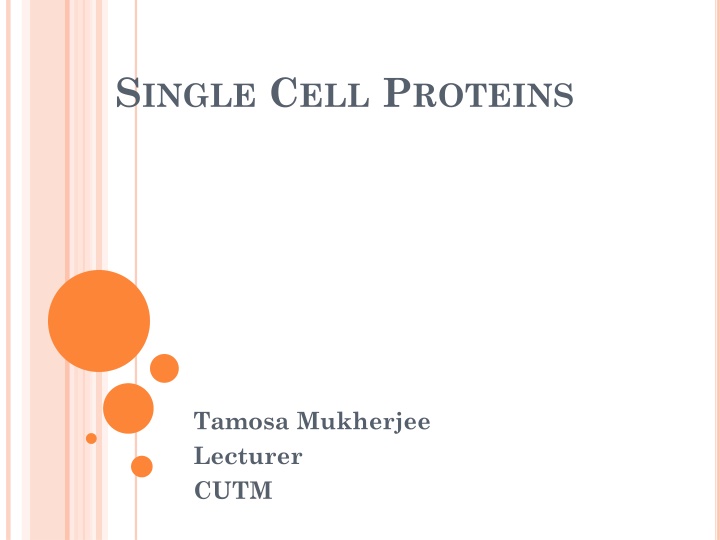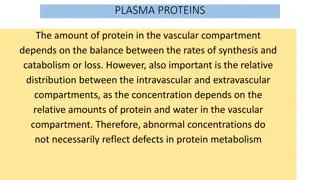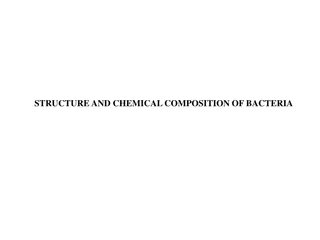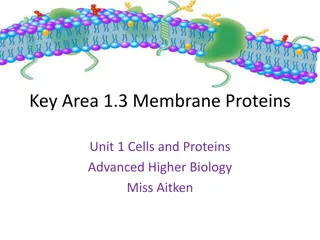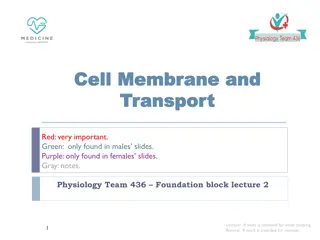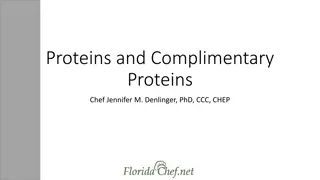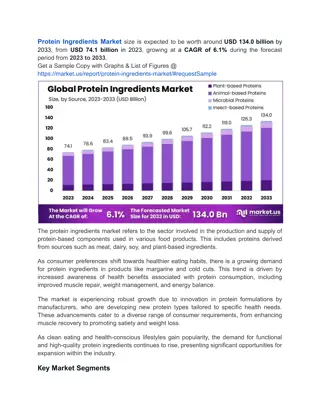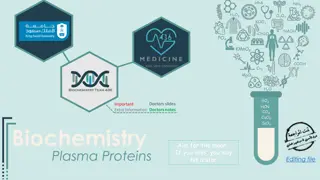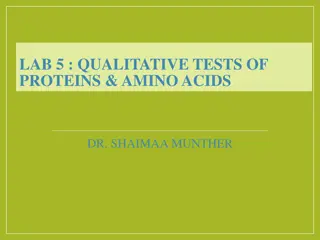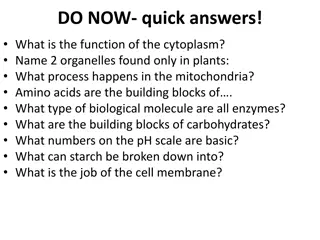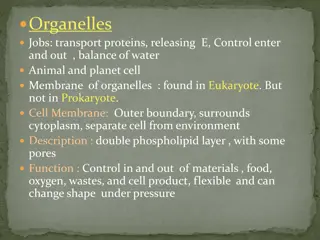SINGLE CELL PROTEINS
As the world population continues to rise, the need for alternative sources of food becomes imperative. Single-cell proteins, derived from microbes, offer a sustainable solution with advantages such as rapid growth, versatile raw material usage, and genetic manipulation capabilities. However, limitations such as high nucleic acid content, presence of toxins, and production costs must be carefully considered. Exploring the potential of single-cell proteins can revolutionize the way we meet food demands in the future.
Download Presentation

Please find below an Image/Link to download the presentation.
The content on the website is provided AS IS for your information and personal use only. It may not be sold, licensed, or shared on other websites without obtaining consent from the author.If you encounter any issues during the download, it is possible that the publisher has removed the file from their server.
You are allowed to download the files provided on this website for personal or commercial use, subject to the condition that they are used lawfully. All files are the property of their respective owners.
The content on the website is provided AS IS for your information and personal use only. It may not be sold, licensed, or shared on other websites without obtaining consent from the author.
E N D
Presentation Transcript
SINGLE CELL PROTEINS Tamosa Mukherjee Lecturer CUTM
Why do we need need alternative sources of food? About 50 years ago (1934-1938) the less developed areas of the world, Asia, Africa and South America, were the main exporters of grain to the developed world. Since 1948 the food flow has reversed, from the developed world to the less developed, mainly due to the rate of growth of the world's population which was much higher in the less developed countries. Based on present trends United Nations (UN) population experts project that there will be 8 billion people living on this planet by 2015 and 10.5 billion by the year 2110. This means that during the 35-year period (1980-2015) we must produce as much food as we have since the dawn of agriculture about 12000 years ago.
Single Cell Protein is a protein extracted from cultured algae, yeasts, or bacteria and used as a substitute for protein- rich foods, especially in animal feeds or as dietary supplements. Many types of animal feeds contain single cell proteins. 60-80% dry cell weight; contains nucleic acids, fats, CHO, vitamins and minerals Rich in essential amino acids (Lys-Met) Microbes can be used to ferment some of the vast amounts of waste materials, such as straws; wood and wood processing wastes; food, cannery and food processing wastes; and residues from alcohol production or from human and animal excreta.
Single-cell proteins develop when microbes ferment waste materials (including wood, straw, cannery, and food-processing wastes, production, hydrocarbons, or human and animal excreta). residues from alcohol The problem with extracting single-cell proteins from the wastes is the dilution and cost. Found in very low concentrations, usually less than 5% Engineers have developed ways to increase the concentrations including precipitation, coagulation, and filtration, or the use of semi-permeable membranes. centrifugation, flotation,
Advantages of using Microorganisms 1. Microorganisms grow at very fast rate under optimal conditions 2. Quality and quantity is better than higher plants and animals 3. Wide range of raw materials can be used 4. Culture and fermentation conditions are simple 5. Microorganisms can be genetically manipulated
Limitations of using SCP 1. Nucleic acid content is very high (40% algae; 10- 15% bacteria and 5-10% yeast) 2. Presence of carcinogenic and toxic substances 3. Contamination of pathogenic microorganisms 4. Indigestion and allergic reactions 5. Production of food grade SCP is expensive
Some SCPs Microbes employed include Algae Chlorella and Spirulina Yeasts Saccharomyces cerevisiae, Pichia pastoris, Candida utilis=Torulopsis and Geotrichum candidum (=Oidium lactis)), other fungi Aspergillus oryzae, Fusarium venenatum, Sclerotium rolfsii, Polyporus and Trichoderma), Bacteria Rhodopseudomonas capsulata Typical yields of 43 to 56%, with protein contents of 44% to 60%.
SCP can be produced from high energy sources: Alkanes, methane, ethanol, methanol, gas oil Generally bacteria and yeasts are employed Pekilo: a fungal protein rich product Paecilomyces variotii is used for production of Pekilo This protein was produced by fermentation of wastes such as molassess, whey, sulfite liquor and agricultural wastes Quorn: mycoprotein for humans Produced by Fusarium graminearum; It is dried and artificially flavoured and marketed in pieces that resemble beef, pork and chicken. Rich in essential nutrients and good content of dietary fibre.
Single cell protein has the potential to be developed into a very large source of supplemental protein that could be used in livestock feeding. Methods available for concentrating include, filtration, precipitation, coagulation, centrifugation, and the use of semi-permeable membranes. These de-watering methods require equipment that is quite expensive and would not be suitable for most small-scale operations. Removal of the amount of water necessary to stabilize the material for storage, in most instances, is not currently economical. Single cell protein must be dried to about 10 % moisture, or condensed and acidified to prevent spoilage from occurring, or fed shortly after being produced.
A wide range of substrates can be used to grow microbial proteins whey, orange peel residue, sweet orange residue, sugarcane bagasse, paper mill waste, rice husks, wheat straw residue, cassava waste, sugar beet pulp, coconut waste, yam waste, banana pulp, mango waste, grape waste, sweet potato Single cell protein was a suitable supplemental protein source for lactating dairy goats. Milk production and milk production efficiency was increased when single cell protein replaced groundnut meal in lactating goat diets SCP from sewage wood wastes High energy sources like methanol, alkanes, methane, ethanol
Properties of SCP One of the main advantages of SCP compared to other types of protein is the small doubling time of cells (td) as shown below. Mass doubling time (S) Due to this property, the productivity of protein production form micro- organisms is greater than that of traditional proteins Efficiency of protein production of several protein sources in 24 hours
Spirulina Common name for human and animal food supplements produced primarily from two species of cyanobacteria (also known as blue-green algae): Arthrospira platensis, and Arthrospira maxima.Use only CO2 and sunlight Used as a human dietary supplement as well as a whole food and is available in tablet, flake, and powder form. It is also used as a feed supplement in the aquaculture, aquarium, and poultry industries Spirulina tablets http://upload.wikimedia.org/wikipedia/commons/thumb/1/1f/Spirul2.jpg/200px-Spirul2.jpg
Nutrients Protein Spirulina contains an unusually high amount of protein, between 55% and 77% by dry weight, depending upon the source. It is a complete protein, containing all essential amino acids, though with reduced amounts of methionine, cysteine, and lysine when compared to the proteins of meat, eggs, and milk. It is, however, superior to typical plant protein, such as that from legumes Essential fatty acids Spirulina is rich in gamma-linolenic acid (GLA), and also provides alpha- linolenic acid (ALA), linoleic acid (LA), stearidonic acid (SDA), eicosapentaenoic acid (EPA), docosahexaenoic acid (DHA), and arachidonic acid (AA) Vitamins Spirulina contains vitamin B1 (thiamine), B2 (riboflavin), B3 (nicotinamide), B6 (pyridoxine), B9 (folic acid), vitamin C, vitamin D, and vitamin E. A one gram tablet could provide more than three times the recommended daily intake of B12. Minerals Spirulina is a rich source of potassium, and also contains calcium, chromium, copper, iron, magnesium, manganese, phosphorus, selenium, sodium, and zinc. Photosynthetic pigments Spirulina contains many pigments including chlorophyll-a, xanthophyll, beta- carotene,zeaxanthin, canthaxanthin, plus the phycobiliproteins c-phycocyanin and allophycocyanin.
Chlorella Senedesmus single-celled green algae without flagella Contains the green photosynthetic pigments chlorophyll-a and -b in its chloroplast. Through photosynthesis it multiplies rapidly requiring only carbon dioxide, water, sunlight, and a small amount of minerals to reproduce Potential source of food and energy because its photosynthetic efficiency can, in theory, reach 8%, comparable with other highly efficient crops such as sugar cane. It is also an attractive food source because it is high in protein and other essential nutrients; when dried, it is about 45% protein, 20% fat, 20% carbohydrate, 5% fiber, and 10% minerals and vitamins. However, because it is a single-celled algae, harvest posed practical difficulties for its large- scale use as a food source. Mass-production methods are now being used to cultivate it in large artificial circular ponds
SCP's Evaluation and Future Prospects The development of SCP was really the beginning of biotechnology. Prior to this the industrial fermentation was mainly focused on antibiotics and other products which did not have to compete. This was not the case with SCP which had to compete with similar products in the market. The development was brought up by the oil companies rather than the food companies, because they could take the risk of a highly costly product out with no real expected profit. They also had all the high technology required. The efforts tried so far by adding dry SCP as a supplement to diets in order to solve the problems of the hungry in the Third World Countries, certainly have not given the expected results. Every new food which appears in the market should have not only high nutritive quality, but also satisfactory organoleptic (Organoleptic refers to any sensory properties of a product, involving taste, colour, odour and feel) supplementary element.
